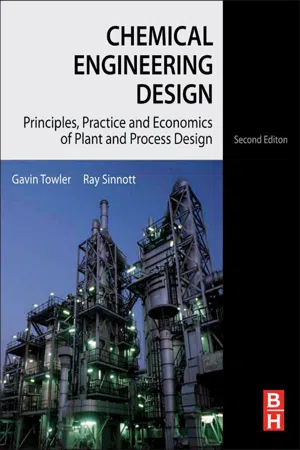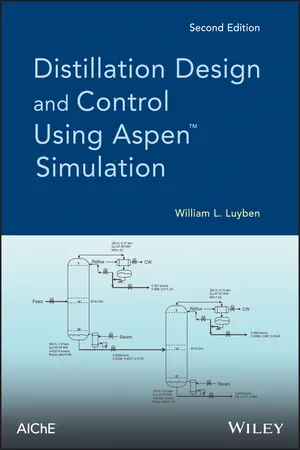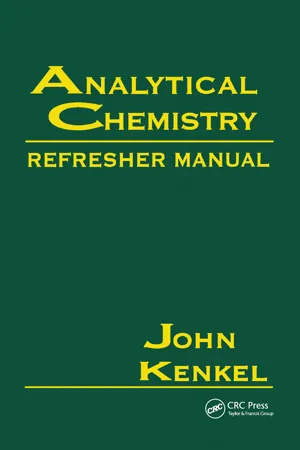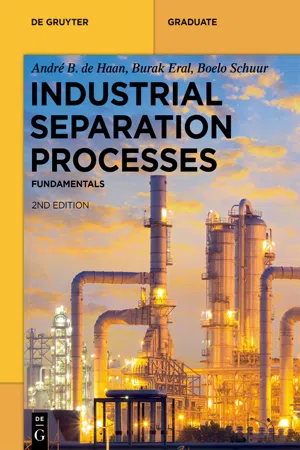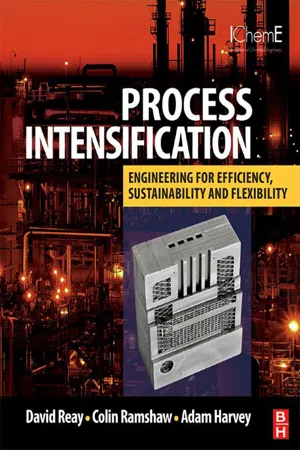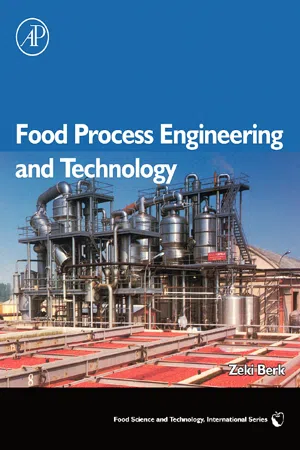Chemistry
Fractional Distillation
Fractional distillation is a process used to separate mixtures of liquids with different boiling points. It involves heating the mixture to vaporize the components and then cooling and condensing the vapors at different temperatures to collect the individual components. This technique is commonly used in the petroleum industry to separate crude oil into its various components such as gasoline, diesel, and kerosene.
Written by Perlego with AI-assistance
7 Key excerpts on "Fractional Distillation"
Learn about this page
Index pages curate the most relevant extracts from our library of academic textbooks. They’ve been created using an in-house natural language model (NLM), each adding context and meaning to key research topics.
- eBook - ePub
Chemical Engineering Design
Principles, Practice and Economics of Plant and Process Design
- Gavin Towler, Ray Sinnott(Authors)
- 2012(Publication Date)
- Butterworth-Heinemann(Publisher)
Reactive distillation is the name given to a process where the chemical reaction and product separation are carried out simultaneously in one vessel. Carrying out the reaction, with separation and purification of the product by distillation, gives the following advantages:1. Chemical equilibrium restrictions can be overcome if a product is removed as it is formed.2. Energy savings can be obtained if the heat of reaction can be used for the distillation.3. Capital costs are reduced, as only one vessel is required.The design of reactive distillation columns is complicated by the complex interactions between the reaction and separation processes. Detailed discussion of reactive distillation is given by Towler and Frey (2002) and Sundmacher and Kiene (2003) .Reactive distillation is used in the production of MTBE (methyl tertiary butyl ether) and methyl acetate.17.9.5 Petroleum Fractionation
Petroleum mixtures such as crude oil and the products of oil refining processes contain from 102 to greater than 105 components, typically including almost every possible hydrocarbon isomer in the boiling range of the mixture. It is usually neither necessary nor desirable to separate these mixtures into pure components, as the processing goal is to form mixtures with suitable properties, such as volatility and viscosity, for use as fuels. The mixture is distilled into fractions or cuts that have a suitable boiling range for blending into a fuel or sending for additional processing. The distillation of mineral oils is therefore known as fractionation , although this term is sometimes also applied to conventional multicomponent distillation.The specifications for fractionation columns are usually not set in terms of key components. Instead, the designer specifies cut points for the product streams. The cut points are points on the product stream boiling curve, typically at 5% and 95% of the total material distilled. The sharpness of separation between two fractions is then measured by the overlap between the 95% cut temperature of the lighter fraction and the 5% cut temperature of the heavy fraction. - William L. Luyben(Author)
- 2013(Publication Date)
- Wiley-AIChE(Publisher)
Chapter 11 Control of Petroleum FractionatorsUp to this point in this book, we have looked at distillation columns that separate specific chemical components. In the refining of crude oil, mixtures of many thousands of components must be handled. These components vary from quite light hydrocarbons (methane, ethane, propane, etc.) to very high-molecular-weight components that boil at extremely high temperatures. Petroleum refineries have units that separate (by distillation) and transform (by a variety of reactions) these mixtures.Crude oil is produced in hundreds of locations around the world. It is found underground, sometimes under high pressure, and sometimes requiring pumping. A vast system of pipelines and huge supertankers transport the crude oil to refineries in which it is processed to make a large number of important products, such as gasoline, heating oil, jet fuel, asphalt, and wax. Most of the raw feed stocks for the chemical industry are produced in refineries, such as ethylene, propylene, and benzene.The initial separation of crude oil into several “cuts” is achieved in a very large distillation column called a “pipestill” or “atmospheric crude distillation” unit. These cuts have different boiling point ranges. Low-molecular-weight gas comes off the reflux drum as a vapor product from a partial condenser. The liquid product from the reflux drum is a light low-boiling naphtha. Products of jet fuel, heating oil, and a heavy high-boiling gas oil are removed as sidestreams from the column. The effluent from a catalytic cracking reactor is also a mixture of petroleum fractions, which are separated in a distillation column called a cat fractionator. Many other units in a refinery must deal with these complex mixtures.Crude oil as it comes from the ground is usually a mixture of saturated hydrocarbons, such as paraffins and naphthenes. The effluent of a cat cracker contains both saturated and unsaturated hydrocarbons, such as aromatics and olefins. These differences in the type of components affect the density and average molecular weight of the petroleum fraction for the same boiling point range.- eBook - ePub
- John Kenkel(Author)
- 2020(Publication Date)
- CRC Press(Publisher)
Organic liquids that are contaminated with other organic liquids usually constitute a much more difficult situation. Such liquids probably have such similar boiling points and vapor pressures that a distillation of a mixture of two or more would result in all being present in the distillate (the condensed vapors) — an unsuccessful purification. However, the liquid that has the highest vapor pressure and/or lowest boiling point, while not being completely purified, would be present in the distillate at a higher concentration level than the other components. It follows that if the distillate were then to be redistilled, perhaps over and over again, further enrichment of this component would take place such that an acceptable purity would eventually be obtained. However, the time involved in such a procedure would be prohibitive. A procedure known as “Fractional Distillation,” solves the problem.Fractional Distillation involves repeated evaporation/condensation steps before the distillate is actually collected. These repeated steps occur in a “fractionating column” (tube) above the original heated container — a column that contains a high surface area inert material for condensing the vapors. As the vapors condense on this material, the material itself heats up and the condensate reevaporates. The reevaporated liquid then moves further up the column, contacts more cold inert material, and the process occurs again and again and again as the liquid makes its way up the column. If a fractionating column were used that is long enough and contains a sufficient quantity of the high surface area material, any purification based on differences in boiling point and vapor pressure can be affected. A schematic diagram of a distillation apparatus fitted with a fractionating column is shown in Figure 8.1 . The high surface area packing material in a fractionating column typically consists of glass beads, glass helices, or glass wool.Each time a single evaporation / condensation step occurs in a fractionating column, the condensate has passed through what has been called a “theoretical plate.” A theoretical plate is thus that segment of a fractionating column in which one evaporation/condensation step occurs. The name is derived from the concepts in which the condensate is actually captured on small “plates” inside the fractionating column from which it is again boiled and evaporated. A fractionating column used for a given liquid mixture is then identified as having a certain number of theoretical plates, and given liquid mixtures are known to require a certain number of theoretical plates in order to achieve a given purity. The “height equivalent to a theoretical plate,” or HETP, is the length of fractionating column corresponding to one theoretical plate. If the number of theoretical plates required is known, then the analyst can select a height of column that would contain the proper number of plates according to manufacturer’s specifications or according to his own measurements of a homemade column. Height selection is not entirely experimental, however. The use of liquid-vapor composition diagrams to predict the theoretical plates required can help. These diagrams are based on boiling point and vapor pressure differences in a pair of liquids. Further discussion of the use of these diagrams is beyond the scope of this book. - eBook - ePub
Industrial Separation Processes
Fundamentals
- André B. de Haan, H. Burak Eral, Boelo Schuur(Authors)
- 2020(Publication Date)
- De Gruyter(Publisher)
Chapter 2 Evaporation and Distillation2.1 Separation by evaporation
2.1.1 Introduction
A large part of the separations of individual substances in a homogeneous liquid mixture or complete fractionation of such mixtures into their individual pure components is achieved through evaporative separations. Evaporative separations are based on the difference in composition between a liquid mixture and the vapor formed from it. This composition difference arises from differing effective vapor pressures, or volatilities, of the components in the liquid mixture. The required vapor phase is created by partial evaporation of the liquid feed through adding heat, followed by total condensation of the vapor. Due to the difference in volatility of the components, the feed mixture is separated into two or more products whose compositions differ from that of the feed. The resulting condensate is enriched in the more volatile components, in accordance with the vapor–liquid equilibrium (VLE) for the system at hand. When a difference in volatility does not exist, separation by simple evaporation is not possible.The basis for planning evaporative separations is knowledge of the VLE. Technically, evaporative separations are the most mature separation operations. Design and operating procedures are well established. Only when VLE or other data are uncertain, a laboratory and/or pilot plant study is necessary prior to the design of a commercial unit. The most elementary form is simple distillation in which the liquid mixture is brought to boiling, partially evaporated and the vapor formed is separated and condensed to form a product. This technique is commonly used in the laboratory for the recovery and/or purification of products after synthesis in an experimental setup as illustrated in Figure 2.1 - eBook - ePub
Food Processing Technology
Principles and Practice
- P.J. Fellows(Author)
- 2009(Publication Date)
- Woodhead Publishing(Publisher)
These are necessary to avoid sandiness, a texture defect that affects the mouthfeel. Further information is given by Goff (2007). 14.2 Distillation Distillation is the separation of more volatile components of a liquid mixture from less volatile components by the application of heat. The volatile-rich vapours are condensed to form a concentrated product. Although common in the chemical industry, distillation in food processing is mostly confined to the production of alcoholic spirits and the preparation of volatile flavour and aroma compounds (e.g. production of essential oils and other flavouring ingredients, or aroma recovery in evaporation). 14.2.1 Theory In a liquid that contains two components, for example alcohol and water, the molecules are attracted to each other by van der Waals forces. The intermolecular forces (or linkages) that attract similar molecules are greater than those that attract dissimilar molecules. This has two important implications for distillation: first, a dilute alcoholic feed material is easier to distil than a more concentrated feed liquor. This is because in dilute solutions the alcohol molecules are separated by a larger number of water molecules and there are thus fewer of the stronger alcohol-alcohol linkages and more of the weaker alcohol–water linkages. Therefore on heating the weaker alcohol–water linkages are broken more easily and the more volatile alcohol is vaporised. A feed liquor for alcohol distillation is typically 5–7% ethanol rather than the more usual 10-13% found for example in wines (see also fermentation in Chapter 6, section 6.4.3). The second implication of intermolecular attraction is that the distillate contains a high proportion of alcohol molecules, and thus a large number of the stronger alcohol–alcohol linkages. This makes it much more difficult to further concentrate the alcohol by a second distillation - eBook - ePub
Process Intensification
Engineering for Efficiency, Sustainability and Flexibility
- David Reay, Colin Ramshaw, Adam Harvey(Authors)
- 2011(Publication Date)
- Butterworth-Heinemann(Publisher)
After Reactions, separations are the most important unit operations within the chemical industry. Separations are also essential components of many other process industry sectors, in particular food and drink, paper and board, and textiles – where the removal of liquids in drying and the concentration of liquids (e.g. in soft drinks manufacture) are highly energy-intensiveDistillation is the most significant separation processes within the process industries. It is a major energy user in the chemicals sector where, together with drying and evaporation, it consumed the equivalent of a million tonnes of oil in the UK in 2004. Distillation columns are used in many operations, the main ones being:• Crude oil distillation • Distillation of petroleum fractions • LPG separation and gas processing • General hydrocarbon separation • Aromatic separation • Water/organics separation • Water/inorganics separation.A number of approaches can be adopted to reduce energy use in the columns, two major examples of which can involve process intensification. The first of these, improvements to the distillation column population to make the units more efficient rather than wholesale replacement by intensified alternative separation methods, is the most likely route in the short- to medium-term, covered briefly below. In the longer term, alternative plant or separation techniques are needed. Potentially the most important of these is HiGee.There are a variety of other ‘conventional’ separation methods used for evaporation and drying processes and these can also benefit from the application of PI. Topics such as dewatering using centrifuges and the application of electrical enhancement methods to speed up drying are also discussed below.6.2 Distillation
6.2.1 Distillation – Dividing Wall Columns
Dividing (or divided – the term varies) wall columns are a convenient way of putting two distillation columns into one shell, the ‘wall’ separating the two functions. Their use is applicable where three or more components require separating. Normally this needs two or more columns, with each column having its own reboiler and condenser – which is energy-inefficient, capital intensive and takes up a lot of space. Kaibel (2007) points out that there are two main types of dividing wall columns. The simpler type represents a column which has the dividing wall assembled either at the upper or lower end of the column (visible in Figure 6.1 - eBook - ePub
- Zeki Berk(Author)
- 2008(Publication Date)
- Academic Press(Publisher)
The gas is thus enriched in volatile component as it moves up and the liquid is stripped of its more volatile component as it flows down the column. The liquid obtained by condensation in the condenser is divided into two parts: one part is fed back into the column in order to provide sufficient liquid for contact with the gas. This part is called the reflux. The other part is the distillate. Vapor can be taken out and condensed at any position on the column, producing distillates of fractions of different compositions, hence the name of ‘Fractional Distillation’ given to the process. Figure 13.7. Schema of a Fractional Distillation column 13.5.2. Analysis and design of the column The design of a distillation column comprises the determination of the number of contact stages, selection of the type of ‘plates’, calculation of the column dimensions, calculation of the heat exchange at the reboiler and the condenser, the design and selection of the auxiliary equipment (piping, pumps, measurement and control systems) etc. (Treybal, 1980 ; Stichlmair, 1998 ; Petlyuk, 2004). The process specifications are: the flow rate, composition and thermal properties of the feed, the desired composition of the distillate and the expected yield. A basic requirement for the design is knowledge of the liquid–vapor equilibrium data for the mixtures involved. Software programs are available for the complete design of the process and the equipment. Here, we shall describe a simplified graphic method for the Fractional Distillation of a binary mixture. The method, known as the McCabe–Thiele procedure, assumes that the molar heats of evaporation of most liquids of interest is about 40 kJ/mol and do not differ much from each other (e.g
